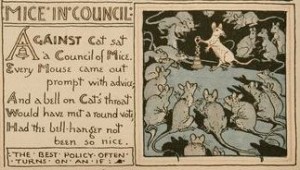
- As noted earlier, the next all-out debacle on the CPSIA front is expected to result from the law’s tracking and labeling regulations, due to take effect August 14, and for which the CPSC has not yet issued guidance, although product makers ordinarily need to resolve crucial issues of manufacturing (as with etching of lot numbers) and packaging at least many months if not longer in advance of sale. Sharon McLoone at CNNMoney had quite a good report a week ago on this latest crisis, which as of this writing has not been followed up much of anywhere else in the press. This continues the pattern in which 1) most key elements of the ongoing CPSIA disaster get good coverage in at least one (sometimes more) major media outlets; 2) the bigger-picture disaster of the law never quite succeeds in breaking out into general coverage as a national story, in large part because 3) the agenda-setting New York Times never consents (even six months into the story!) to give the matter any coverage at all. For more hints on the approaching tracking-label train wreck, see this op-ed by a South Carolina maker of school supplies (“Companies such as ours are now forced to guess about their new legal requirements. … My company may have to change labels hundreds of times a week in our two factories. The investment necessary to handle this new rule alone is crippling.”), or the comments of appliquéd bib maker Laurel Schreiber of Lucy’s Pocket (if the testing doesn’t get her, the tracking labels will), or of New Jersey wooden toy maker John Greco (advised that tracking info would add $3.50 to $5.00 to cost of making $10 handmade toy). And here’s a view from the home furnishings business.
- No, the menace to pre-1985 children’s books has not gone away, not in the least. Librarians and publishers remain on the edge of their seats awaiting exemptions, clarifications or both. There was some good coverage last month in the Sioux Falls Business Journal (store owner Jenny Cook “had to throw out only 30 books at her store to comply” because most were newer; “Siouxland Libraries has pulled a list of books that were published before 1985”) and at Syracuse.com (“When you think through the implications, it means closing our libraries to children”). And in a sign of possible things to come, ABC-affiliated stations in Seattle and Washington, D.C. have now run sensationalist “toxic books!” attacks on local libraries [Common Room, ShopFloor] More: Winifred Maker, Anderson Valley Post (April).
- The CPSC’s stay of enforcement didn’t really solve the problem of the ban on dirtbikes and mini-ATVs, and responsible users and dealers end up getting the short end of the stick [Jason Giacchino/ATVSource, Vince Castellanos/ESPN FMX, Motorcycle Industry Council, Charleston (S.C.) Post and Courier]
- Downtown Los Angeles is home to an estimated 500 toy companies — most of them far smaller than crosstown giant Mattel — and they’re in much distress from the law. [Alexa Hyland, L.A. Business Journal] The L.A. Times, which once gave serious scrutiny to the law’s effects on the apparel and resale sectors, seems (scroll) to be dropping the ball.
- Those who remain in the kids’-product business after coping with all the other parts of the law will also want to educate themselves about “recall escrows” [Rick Woldenberg]
- Inez Tenenbaum, named by Obama as new CPSC chair, had her confirmation hearing on Tuesday [ShopFloor and more, Rick Woldenberg]. Nancy Nord earlier stepped down from her role as acting chair.
- What, what, what could they have been thinking? The American Library Association has actually given its 2009 Public Service Award to California Senator Barbara Boxer, a key architect of some of CPSIA’s provisions; the retroactive phthalates ban she championed has been especially effective in forcing “books-plus” off library shelves, and she has turned a coldly unsympathetic ear to cries of distress over the law (via @melanes). To repeat: what could the ALA have been thinking?

Public domain images courtesy ChildrensLibrary.org: Walter Crane, illustrator, The Baby’s Aesop (1887).

5 Comments
I have been writing an introductory book on electronics, tailored for young readers. I was thinking of packaging and selling a complete kit of components for all the experiments in the book, when the horror-acronym “CPSIA!” flashed into my consciousness and I realized that such an idea is utterly out of the question, since components often contain not just one but several ingredients that are outlawed by the act.
How about if I sell the components to anyone who submits a signed statement that he is over 18? I’m not so sure about that. The book clearly is for young people, so anything I do of this sort could be viewed as an attempt to circumvent the law fraudulently. I can hear the prosecutor’s words now: “Mr. Platt, do you really expect the court to believe that when you sold components for projects in a book clearly intended for young people, you had no idea that young people would be using the components?”
In fact I am now wondering if I am running afoul of CPSIA merely by _writing_ something which encourages young people to buy stuff that is chock full o’ lead. Am I engaged in a conspiracy? Is this all too theoretical and paranoid? Until we start accumulating test cases, who the hell knows? And personally I do not wish to be a test case. I just wish to write a book to encourage young people to get hooked on electronics, so that we will have more electronic engineers in the future, maybe improving the world for future generations. But since toxic chemicals will always be involved in electronics, maybe the future generations are out of luck.
I had the heart ache of listening to the Inez Tenenbaum hearing on the radio this morning. It is clear that Ms. Tenebaum has no idea what the problem is with CPSIA, namely the idiotic statutory declaration that incidental exposure to lead or phthalates is a hazard to children.
The Chinese Drywall issue came up. If you suggest that Chinese Drywall canl cause breathing problems, then you will get lots of claims that Chinese Drywall caused breathing problems, just as what happened with the World Trade Center claims, Gulf War Syndrome, and Agent Orange. The Senators at the hearing were perplexed when no agent could be found to explain the results. What a bunch, both sides of the aisle, of morons. Complete and absolute morons!
Charles: In a slightly saner world, I’d say you wouldn’t have anything to worry about because the First Amendment would protect you. But these days, there seems to be no limit to what government tries to get away with. Maybe you can shift the emphasis of your planned book a bit to aim it at children 12 years old and older. The CPSIA doesn’t apply to products aimed at them.
[…] a burden that is perhaps bearable for many producers who operate on a large industrial scale; as noted in some detail two weeks ago, however, they are causing much hair-pulling — if not thoughts of retirement or bankruptcy […]
[…] a lot in the process. [Full disclosure, Walter reads my blog, too, and links to it.] He just posted an update that was laden with great links and lots of useful information. I found the topics enraging all […]